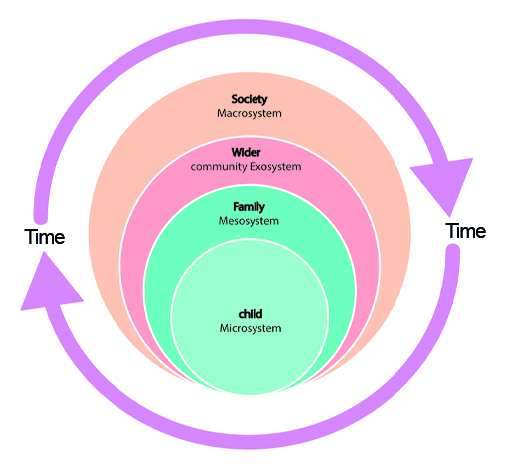5.1 Factors that support the development of resilience in children
The factors that can support the development of resilience in children can be examined by looking at the systems around the child, as illustrated in the diagram that you have already seen in Sessions 1 and 2.
The following highlights some of the factors that can affect how resilience can develop within each of the systems, starting with the child.
The child
There are some factors that can help or hinder the development of resilience in children which are briefly described below:
- Temperament: can be defined as the inborn traits that influence the child’s approach to the world. If a child has an ‘easy’ and ‘outgoing’ temperament, they are perhaps more likely to quickly develop positive relationships. On the other hand, a child who is ‘slow to warm up’ and ‘timid’ may avoid social situations, struggle to develop peer relationships and play alone more frequently.
- Health: a child with a ‘strong constitution’ may join in many physically challenging play experiences, both indoors and outdoors, so they will more easily develop their motor confidence and subsequently have more opportunities to develop resilience through the freedom to explore their environment. They will also feel more able to set themselves personal goals, achieve them and then extend their range of skills.
- Disability: depending on the impairments experienced, a child with a disability may take longer than their peers to adjust to new situations or to learn new skills. For example, children with autism may have higher levels of anxiety in response to new social situations and their behaviour can be off-putting to other children, which can affect the development of peer relationships.
The family
Resilience in children can be fostered if the family or carers can provide a ‘secure base’ for children. A secure base means providing children with love and consistent routines. This facilitates emotional regulation, fosters learning opportunities, promotes social interaction and the development of friendships with other children.
The community
The wider resources that are available in the community can help children to promote resilience by providing opportunities to explore and play. For instance, playgrounds in the local community are an invaluable way of providing opportunities for children to play and explore and develop their social, emotional and physical skills.
Society
The status of children in the society they are growing up in is important in the development of resilience. If children’s rights are recognised and upheld, it is more likely that they will be given opportunities to express themselves and make developmentally appropriate decisions about their lives. They can develop greater feelings of trust and become more resilient when faced with challenging circumstances. However, not all societies regard children as having rights. As you will explore in Session 4, childhood is perceived in different ways. These different perceptions impact on how children cope with adverse conditions and develop resilience.

